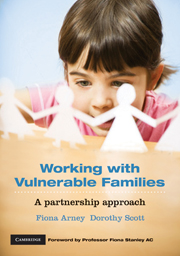Book contents
- Frontmatter
- Foreword
- Contents
- List of figures, tables and boxes
- Contributors
- Acknowledgements
- Introduction
- Chapter 1 Think child, think family, think community
- Chapter 2 Family strengths: an international perspective
- Chapter 3 Harnessing ‘resilience’ when working with children and families
- Chapter 4 Working within and between organisations
- Chapter 5 Family-centred practice in early childhood settings
- Chapter 6 Sustained nurse home visiting with families of Aboriginal children
- Chapter 7 Including fathers in work with vulnerable families
- Chapter 8 Parenting in a new culture: working with refugee families
- Chapter 9 Responding to parents with complex needs who are involved with statutory child protection services
- Chapter 10 Engaging family members in decision making in child welfare contexts
- Chapter 11 Supporting parents whose children are in out-of-home care
- Chapter 12 Using evidence-informed practice to support vulnerable families
- Chapter 13 Spreading promising ideas and innovations in child and family services
- Index
Chapter 6 - Sustained nurse home visiting with families of Aboriginal children
- Frontmatter
- Foreword
- Contents
- List of figures, tables and boxes
- Contributors
- Acknowledgements
- Introduction
- Chapter 1 Think child, think family, think community
- Chapter 2 Family strengths: an international perspective
- Chapter 3 Harnessing ‘resilience’ when working with children and families
- Chapter 4 Working within and between organisations
- Chapter 5 Family-centred practice in early childhood settings
- Chapter 6 Sustained nurse home visiting with families of Aboriginal children
- Chapter 7 Including fathers in work with vulnerable families
- Chapter 8 Parenting in a new culture: working with refugee families
- Chapter 9 Responding to parents with complex needs who are involved with statutory child protection services
- Chapter 10 Engaging family members in decision making in child welfare contexts
- Chapter 11 Supporting parents whose children are in out-of-home care
- Chapter 12 Using evidence-informed practice to support vulnerable families
- Chapter 13 Spreading promising ideas and innovations in child and family services
- Index
Summary
Learning goals
This chapter will enable you to:
Develop an understanding of strengths-based approaches to working with Aboriginal and Torres Strait Islander families
Understand the importance of cross-cultural partnerships when working with Aboriginal and Torres Strait Islander families
Consider the cultural, social and emotional needs of Aboriginal and Torres Strait Islander clients when delivering services
Understand the need to take a ‘whole of family’ approach to improve outcomes for Aboriginal and Torres Strait Islander children
Recognise the characteristics of practitioners that are key to developing positive relationships with families.
Introduction
Australian Aboriginal and Torres Strait Islander families show remarkable strength and resilience. Australian Aboriginal culture is the world's oldest living culture, with knowledge systems evolving over many thousands of years and in adaptation to the changing Australian environment (Gostin & Chong, 1998). Knowledge about cultural practices (including childrearing), spirituality, relationships to land and nature, kinship networks, laws, lores, and rites, have been passed down within and between different cultural groups through ceremony, story, art, dance and song (and today through literature and electronic media) for millennia.
Today, Aboriginal and Torres Strait Islander people are estimated to make up 2.5% of the Australian population, with approximately half (53%) of the Indigenous population living in cities or inner regional areas (Australian Bureau of Statistics, 2008a). Children and young people make up a greater proportion of the Aboriginal population than of the non-Aboriginal population, with approximately half of the Aboriginal and Torres Strait Islander population aged 21 or under, compared to half of non-Aboriginal people being aged 37 or under) (Australian Bureau of Statistics, 2008a).
- Type
- Chapter
- Information
- Working with Vulnerable FamiliesA Partnership Approach, pp. 109 - 134Publisher: Cambridge University PressPrint publication year: 2010
- 3
- Cited by

